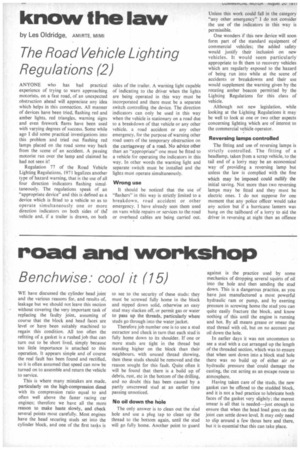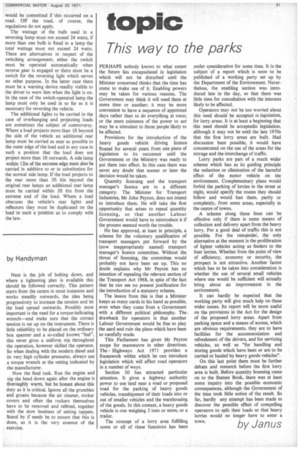road and workshop
Page 32

Page 33

If you've noticed an error in this article please click here to report it so we can fix it.
by Handyman
Benchwise: cool it (15)
WE have discussed the cylinder head joint and the various reasons for. and results of, leakage but we should not leave this section without covering the very important task of replacing the faulty joint, assuming of course that the block and head faces are level or have been suitably machined to regain this condition. All too often the refitting of a gasket is a rushed job that can turn out to be short lived, simply because too little importance is attached to this operation. It appears simple and of course the real fault has been found and rectified, so it is often assumed that speed can now be turned on to assemble and return the vehicle to service.
This is where many mistakes are made, particularly on the high-compression diesd with its compression ratio equal to and often well above the faster racing car engines; therefore we have all the more reason to make haste slowly, and check several points most carefully. Most engines have the head securing studs set into the cylinder block, and one of the first tasks is
to see to the security of these studs: they must be screwed fully home in the block and nipped down solid, otherwise an easy stud may slacken off, or permit gas or water to pass up the threads, particularly where studs go through into the water jacket.
Therefore job number one is to use a stud extractor and check in turn that each stud is fully home down to its shoulder. If one or more studs are tight in the thread but standing higher on the block than their neighbours, with unused thread showing, then these studs should be removed and the reason sought for this fault. Quite often it will be found that there is a build up of debris, rust, etc in the bottom of the drilling, and no doubt this has been caused by a partly unscrewed stud at an earlier time passing unnoticed.
No oil down the hale
The only answer is to clean out the stud hole and use a plug tap to clean up the thread to the bottom again, until the stud will go fully home. Another point to guard
against is the practice used by some mechanics of dropping several squirts of oil into the hole and then sending the stud down. This is a dangerous practice, as you have just manufactured a most powerful hydraulic ram or pump, and by exerting pressure in screwing home the stud you can quite easily fracture the block, and know nothing of this until the engine is running and hot. By all means grease or smear the stud thread with oil, but on no account put oil down the hole.
In earlier days it was not uncommon to see a stud with a cut arranged up the length of the threaded section, which was to ensure that when sent down into a block stud hole there was no build up of either air or hydraulic pressure that 'could damage the casting, the cut acting as an escape route to atmosphere.
Having taken care of the studs, the new gasket can be offered to the studded block, and it is not a bad practice to lubricate both faces of the gasket very slightly; the merest smear is all that is needed—just enough to ensure that when the head load goes on the joint can settle down level. It may only need to slip around a few thous here and there, but it is essential that this can take place. Next is the job of bolting down, and where a tightening plan is available this should be followed correctly. This pattern starts from the centre in most instances and works steadily outwards, the idea being progressively to increase the tension and let the load spread outwards. Possibly most important is the need for a torque-indicating wrench—and make sure that the correct tension is set up on the instrument. There is little reliability to be placed on the ordinary box spanner and a so-called known "feel", this never gives a uniform nip throughout the operation, however skilled the operator. So when dealing with the modern diesel and its very high cylinder pressures, always use a torque wrench at the setting indicated by the manufacturer.
Now the final task. Run the engine and nip the head down again after the engine is thoroughly warm, but be honest about this duty as it is critical. Ignore all the grumbles and groans because the air cleaner, rocker covers and often the rockers themselves have to be removed and refitted, together with the slow business of setting tappets. Stand by if needs be to ensure that this is done, as it is the very essence of the exercise.




















































































